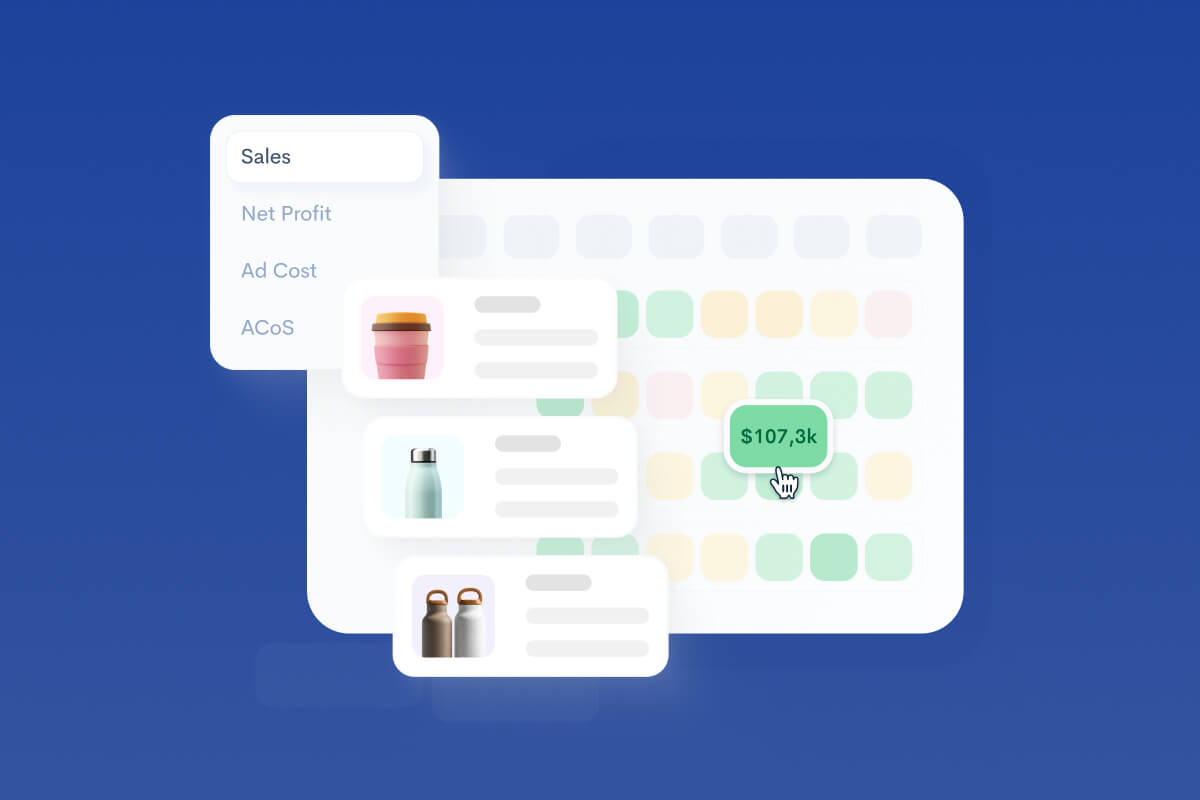How External Traffic Affects Amazon’s A10 Algorithm
Sellerise Team, Contributor
7 min read -
Updated:On the largest eCommerce marketplace in the world, where millions of products compete for consumer attention, a set of mathematical equations determine who will win and who will lose. These mathematical equations are referred to as the Amazon’s A10 algorithm. They are responsible for determining where you as a seller end up getting shown when people search for your products.
One strategic move that has recently been shown to be a game-changer for Amazon’s A10 algorithm is sending external traffic to Amazon listings. This isn’t just about amplifying your product’s reach. It’s about understanding and harnessing a balance between external traffic and Amazon’s sophisticated ranking system.
In this article we are going to look at how external traffic impacts Amazon’s A10 algorithm while also providing actionable insights for sellers on how they can leverage different strategies effectively to turn average listings into marketplace titans.
The A10 Algorithm Explained
In order to fully appreciate the influence of external traffic on Amazon product rankings, it is necessary to first understand Amazon’s A10 algorithm. The A10 algorithm is specifically designed to offer its users with relevant search results that are of high quality. This is achieved by considering several critical factors:
- Sales Velocity: Sales velocity measures the rate at which a product sells over a period of time. High sales velocity indicates strong demand and customer interest meaning that a product was received well and is popular. Consequently products with higher sales velocity tend to appear higher in search result pages. During peak shopping seasons sellers can improve their sales velocity through offering discounts, engaging in advertising campaigns, or utilizing top influencer marketing softwares.
- Product Listing Completeness: The level of detail in a product listing matters a lot. Complete listings provide potential customers with enough information they need to make an informed purchase decision about what they want. Optimized listings should incorporate things such as high-quality images, comprehensive descriptions, complete specifications and full user instructions (also known as A+ content). The listings which comprehensively address potential customers’ queries and concerns are what the Amazon A10 algorithm prefers, recognizing these listings as more valuable to shoppers and improving their search visibility.
- Customer Reviews: Seen as essential for influencing product rankings, customer reviews are quite important. The quality and number of reviews matter. Products with high rates of positive reviews are better ranked due to trust attributed by consumers and the A10 algorithm loves them. Review metrics can be improved if sellers practice good customer service, request post-purchase feedback using review management tools, and respond swiftly to negative feedback to change dissatisfied customers’ opinions.
- Keyword Relevance: For optimum visibility on Amazon, keywords in product listings should be extremely relevant and also targeted toward heavily search terms. Properly placed keywords make a given product match well with queries of potential buyers online. Relevant keywords should be used in the listing’s title, description and backend search terms. If the keyword phrases chosen for a listing closely resemble those being typed into the search box by users, then it is likely that the A10 algorithm will determine it is relevant and place a listing higher on search results.
- Sales Period: Sales period can be described as the elapsed time between two purchases of a given product. This factor compares the regularity and rate of sales. Those with short selling seasons may want to drive more sales during off season to signify that consumers are continuously purchasing their products. A factor that can boost product ranking since it implies that consistent consumer buying habits exist.
- Sales History: This points to the total quantity of sales acquisition in a specific period. A big factor that Amazon considers when ranking products is previous purchase history. This means that if a specific product has frequently been ordered by customers in the past, its ranking is likely to be better than that of products who have sporadic sales or low volume purchases at different times.
- Session Sales Percentage (Conversion Rate): Product listing conversion rate metrics or how often visits to a particular product page tend to end up in a sale are another important variable in the Amazon’s A10 algorithm. Good conversion rates indicate high product desirability, and that a particular product is a hit and sought after by consumers, which will dramatically impact a listings SEO and ranking.
- External Traffic: External traffic metrics are the proportion of visitors and buyers coming from a different platform other than Amazon.com. External traffic is recognized by the A10 algorithm as an indication about the overall popularity of a given product and its tendency to attract and convert customers’ attention. Driving traffic from social media, search engines, influencers, ads, and email marketing pointing to Amazon, will boost up listing rankings and give you an edge over the competition. Moreover, it elevates the sales volume in the short term and informs Amazon that the product is gaining attention from a larger audience. This can contribute to the product’s prominence within the marketplace.
All these factors function collectively and help the A10 algorithm decide the positions of where to place a product when a consumer searches for a targeted keyword. It is necessary that Amazon sellers become very familiar with all the dimensions of these strategies in order to compete and make it big on the Amazon marketplace.
The Best Strategies to Drive External Amazon Traffic
As the Amazon marketplace continues to gain more sellers, activating external traffic to listings on Amazon is increasingly becoming a more important factor to stay competitive. Using external traffic is not only a good way to increase a listing’s visibility, but also now necessary to influence your ranking in Amazon’s complex algorithm. Below we will explore all the best approaches to generating external traffic generation, and the different advantages to each strategy.
Social Media Power
- Influencer Collaborations: Influencers are a great way to drive external traffic sales since they can have very niche engaged audiences who trust their product options. Influencers come in different sizes from Mega-Influencers with large reach but expensive costs to Micro-Influencers with smaller reach but more trustworthy audiences and much cheaper costs. One tool to tap into the power of Micro-Influencer promotions for Amazon growth is, Stack Influence, which enables brands to set influencers on ‘autopilot’, pay them only in product, and drive high velocity external traffic sales to Amazon listings.
- Social Media Ads: Sites such as Instagram and Tiktok have robust ad platforms which can scale external traffic to your listings while targeting geographics and demographics of different audiences among other factors. Global social media users have grown to more than 5 billion so the opportunity to drive lots of traffic is huge.
Content Marketing Essentials
- Blogging: Coming up with useful, search engine friendly content about your products can help in attracting potential buyers and push lots of outside traffic. Blogs have an additional advantage of educating customers before they make purchase decisions, increasing trustworthiness and then generating traffic with direct links to the Amazon listings.
- Video Content: Producing video on platforms like YouTube is another efficient tool in the strategy of driving traffic to Amazon listings. People are more likely to engage in content that visually demonstrates the benefits of a particular product and video is one of the most effective forms. Over a billion hours of YouTube content is watched daily by users, so the reach is very promising.
Leverage Email Marketing
Let us not forget that email continues to be one of the best external traffic marketing tools at Amazon merchants disposal even in the midst of social media taking center stage. Segmented and personalized email marketing campaigns can boast an average open rate of 34%, according to Hubspot and can be one of your best tools to get that valuable outside traffic to your listings.
Tap into Paid Advertising
- Google Ads: Paying for ads that target specific keywords which reflect your product offering, Google Ads can help in generating a lot of traffic. Google processes over 8.5 billion searches each day, which is a massive opportunity to push traffic over to your Amazon listings.
- Affiliate Marketing: Creating commission based incentives to creators, publishers, and other utilizing affiliate marketing strategies is another great tactic to lead consumers to your Amazon listings from external sources. The affiliate model is also efficient since it does not require an upfront marketing budget to implement and mitigates risk of an ad initiative not panning out.
Utilize Deals and Promotions
The use of limited time deals and promo campaigns is also effective in creating a sense of urgency within a consumer base on your website or other promotional source which in-turn can drive traffic to your Amazon store. Sites like Groupon can help you bring your products to a brand new consumer base and get lots of traffic over to your Amazon brand stores.
The Future: Voice Search Optimization
With the growing usage of smart voice devices like Amazon Alexa & Google Home, Voice Search is gaining more and more significance. It is predicted that 80% of all search will be done using voice by the end of 2024, and therefore the need to gear up your voice SEO is urgent.
Monitoring and Adjusting Strategies
Directing outside traffic to Amazon should be a constant process and not a one time initiative.
- Keep an Eye on Performance Metrics: By monitoring click through rates as well as conversion rates, you will be able to gain a clear picture as to how well external links can impact your Amazon ranking and sales.
- Optimize Traffic Sources: Another thing that is important when it comes to driving traffic is figuring out which types of traffic are driving the most velocity when it comes to sales depending on your specific products/niche and adjusting your strategies accordingly.
- Stay Testing: Some tactics will work better than others for your brand so you always should be testing new strategies. Even within one channel you should be running A/B tests to determine what types of content, messaging, and CTA perform the best for your external traffic needs.
Following the steps outlined in this article and by experimenting with all the recommended strategies, you will get on the good side of the A10 algorithm, be able to break through the noise on the Amazon marketplace, and dramatically help your Amazon business grow.
Do not forget that the external traffic strategies must be optimized and done consistently in order to maintain a top position on the Amazon playing field. It’s a jungle out there and external traffic is one of the best ways in 2024 to not only make it out alive on Amazon, but thrive as one of the dominant players.




